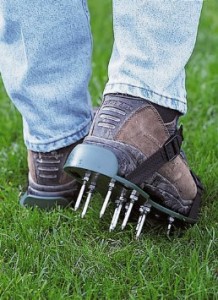Lawn maintenance is the most common activity for gardeners around the United States. Yet some popular lawn-care practices have no basis in reality. They’re myths, says C.L. Fornari, author, speaker, and self-styled “garden geek.” In her newest book, Coffee for Roses, C.L., debunks all kinds of garden lore and hand-me-down tips. So this time of year, as the growl of lawn mowers floats over countless neighborhoods, I’ve asked C.L. to share the truth behind three prevalent turf myths.
Myth: If you have moss, your soil is too acidic. When C.L. speaks to audiences of gardeners, she asks them to tell her what’s the recommended remedy for moss. “And they all say back to me in unison, ‘A bag of lime.’” Although it’s true that grass grows better with a neutral pH, lime is usually not what’s needed. Many mosses like lime, C.L. points out. “Moss grows on limestone in the quarries of Pennsylvania.”
Truth: Three conditions favor moss. “Moisture, compact soil, and shade,” she says. So change the conditions—cut back on watering; aerate the soil; and clip up branches to allow more sunlight. Or, C.L. suggests, grow moss instead of grass.
Myth: Water daily for the lushest lawn. “Every disease, every insect, loves an overly watered lawn,” says C.L. “We don’t live in a rain forest. In our part of the world, plants have not adapted to rain every day so why give it to them?”
Truth: Water only enough to encourage deep root systems. “The surface of the soil should have more dry times than wet,” C.L. says. Depending on weather, deliver one inch of  water each week. That should penetrate the soil six to twelve inches.
water each week. That should penetrate the soil six to twelve inches.
Myth: Aerate the lawn wearing spiked-sole shoes. You’ve seen the ads. Perhaps you’ve been tempted to try the spikes.
Truth: Spikes add to compaction. According to C.L., those goofy shoes make a hole by forcing all the dirt into the surrounding areas. A proper aerating machine creates holes by pulling up plugs of soil. Air and nutrients can slip into the spaces left behind.
Bonus lawn maintenance tip: If you need to replace a patch of lawn, jump-start the grass seed by sowing in a square flat in your greenhouse. The flat makes a template so you know exactly how much lawn to remove for a seamless repair and the grass has a head start protected from the weather.


